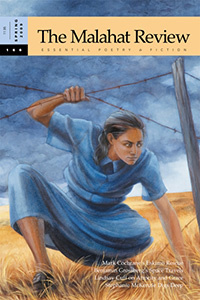Issues
Our Back Pages
Issue #166
Issue Date: Spring 2009
Editor: John Barton
Pages: 128
Number of contributors: 34
Buy Issue 166: Print Edition

Themes of entering the unknown, of discovery, and of love run through the spring 2009 issue, and are reflected in the woman’s face on the cover, as illustrated by Montana-based artist Stephanie J. Frostad. With eagerness, wariness, and curiosity we reach for future relationships and cling to those we have left in the past.
There are many highlights in this issue. I read “Wonder,” by Rosemary Griebel, aloud to two friends, and one remarked, “Now that was a perfect poem.” I have to agree. This piece stands out for its quick and clever imagery that paints an elderly mother in a care home. Here is a wealth of memory, and a life’s legacy, but with memory and life both fading. “Creased maps of upturned palms, shawls heavy as wings. / To the quiet deepening, leave the silence to come.”
In the poem “Jeremy,” by Roxanna Bennett, a woman waits, smoking on museum steps, for a lover who isn’t coming. This is the breaking point where one’s conception of another shifts, where the accumulated experiences of love are suddenly soured or diminished, and forced from present to past. Their relationship becomes etched in intangible memory, so beautifully depicted in these lines: Your shadow still hangs like an atomic silhouette. / No artifacts prove we were here, and did love, briefly.”
Another memorable poem is “If Thunder is Anything,”by Laisha Rosnau, which evokes a feeling of rustic love in snapshots, like flashes of lightning in a dark forest. In very visual glimpses, we see a couple swimming in a lake beneath storm clouds, and later curled up like commas, hearts beating loudly within a tent. “If thunder is anything, it is your face lit.”
Ben Lof’s unforgettable story, “When in the Field with Her at His Back” opens the issue. Set in Croatia, there are landmines, both emotional and literal, to be navigated. In “Buyer’s Market” by Peter Gilmour, the narrator, following his wife’s suicide, decides to show the family home to prospective buyers, rather than leaving the task to a realtor. He has much time to reflect as he waits for each appointment, but also as he leads people through the rooms and gardens that echo with so much memory and loss. On the realtor’s advice, he is frank about what happened and why they are moving, which invariable draws more questions, some less welcome than others. There is so much emotion in this story, though it is told in a measured, reflective voice, as the narrator wanders back through his marriage and wonders what led to his wife’s haunting end, and how much he contributed to her silent depression.
“On Atrocity and Grace: A Contrapuntal Vision” is the excellent nonfiction piece in this issue. Lindsay Cuff explores the corruption of love manifest in abuse and familial trauma, and its aftermath twenty years on. When the narrator is eleven, she learns that her uncle has been sexually abusing her cousin, and that he will be sent to jail. This is the legacy of atrocity, and by seeking grace as a filter on this difficult family history, the narrator attempts to find a new balance two decades later as her uncle is released from prison. Her grace is neither forgiveness nor acceptance, but simply an acknowledgement that the past exists in the past.“If atrocity is the falling, then maybe grace is what dances between. It is the space that makes atrocity not pure atrocity. It is not its opposite, nor its explanation. The silence in one creates space for the other. This has happened. But this is happening too.”
—David Brown









